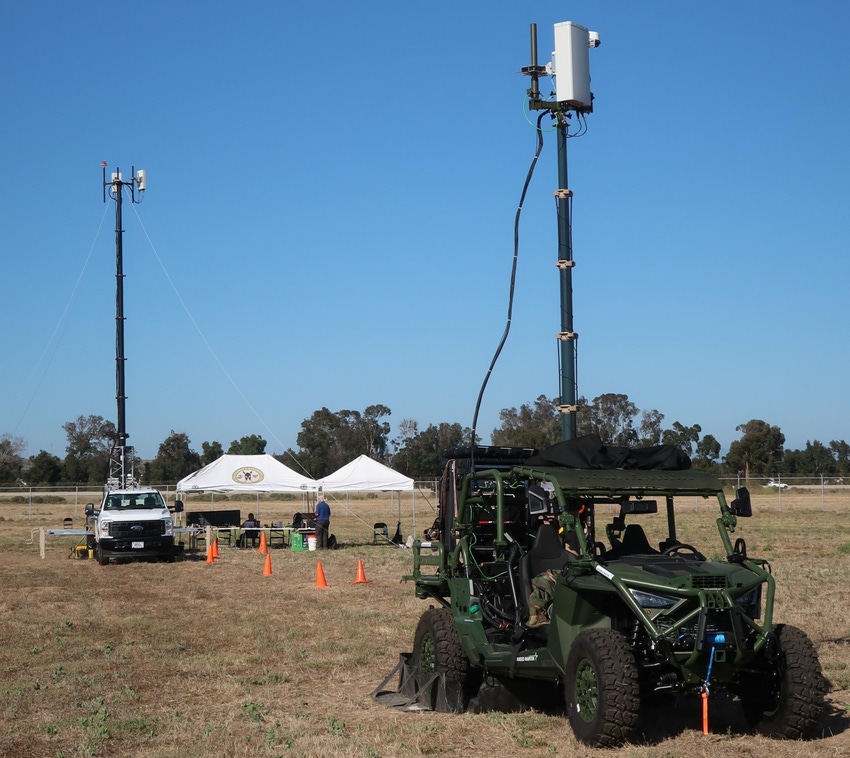
Lockheed Martin's Dan Rice doesn't see 5G powering all military connections in the future, but he does envision it playing a major role.
Rice, who is VP of Lockheed's 5G.MIL programs, is in charge of the company's "all-domain" connectivity 5G program. "All-domain" is military-speak for operations on land, in the sea, in the skies and in space. Lockheed is the US military's largest contractor, by a wide margin.
"Our vision is not to simply replace every radio ... with a 5G radio," he told Light Reading. "It is not that."
Rice explained that he expects 5G to be "a fairly significant part" of the US military's JADC2 program. As Light Reading has previously reported, JADC2 stands for Joint All-Domain Command and Control, and it's the Pentagon's vision for connecting "sensors with shooters across all domains, commands and services." Meaning, it would be a comprehensive, interoperable wireless networking system that would basically connect everything owned and operated by the Pentagon.
5G is "one of 10 or a dozen critical technologies" for JADC2, Rice said, adding that while JADC2 remains a broad goal for the Pentagon, it likely won't come to complete fruition anytime soon.
Investments into open RAN
In chasing the idea of JADC2, the US Department of Defense (DoD) has been spending heavily on 5G, allocating roughly $650 million over the past three years to various research and development projects. "We estimate roughly $100 billion a year of R&D that the commercial industry puts into telecommunications. So, that's how they're advancing," Thomas Rondeau, the Defense Department's principal director for FutureG, said recently, according to Defense One. Rondeau explained that the US military hopes to tap into part of that investment and innovation.
Notably, much of the military's focus has been on the open RAN flavor of 5G.
With open interfaces, "we can actually consume things better and not be locked into vendors and then we can actually make 5G – our network and capacity – more ubiquitous and, dare I say, more commoditized and not necessarily tied to vendors or carriers," explained Young Bang, principal deputy assistant secretary of the Army for acquisition, logistics and technology, during a recent conference, according to National Defense.
Rice agreed. "We're trying to create an open environment," he said, because that way Lockheed can leverage equipment from multiple vendors.
Lockheed's communication goals
Rice traces Lockheed's interest in 5G to the appointment of James Taiclet as the company's CEO in 2020. Taiclet served as a pilot in the Gulf War under the callsign "Cheetah23" before ultimately becoming the CEO of American Tower, one of the biggest cell tower operators in the US.
When he joined Lockheed, Taiclet launched the company's 5G.MIL program.
"It is an enterprise-wide initiative," Rice said.
To be clear, other military contractors like Northrop Grumman are also chasing the JADC2 and 5G opportunities.
Rice said 5G technology "is designed to be discoverable," which is ideal in commercial mobile networks. However, "sometimes that's not an attribute that a military unit would like to have."
As a result, Lockheed is working to integrate 5G into other military communications systems, potentially using software-defined radios, according to Rice.
Lockheed is working to create a heterogeneous network design that relies on a distributed architecture, thereby making it more useful and resilient across different branches of the military and in different scenarios, Rice said. Edge computing will play into that design by allowing individual elements within that network to conduct their own, independent computing operations, he added.
Testing for success
Lockheed has announced a variety of 5G tests, including one in August that showed off Lockheed's new Open Systems Interoperable and Reconfigurable Infrastructure Solution (OSIRIS) platform. It's basically a portable 5G network that soldiers can set up and operate virtually anywhere. According to Lockheed, that test used an Open Radio Unit (O-RU) with Lockheed Martin's hybrid basestation running Intel's FlexRAN reference software and Xeon processors.
"The OSIRIS system is one of the first tactical 5G standalone small cell systems compliant with the Open-Radio Access Network (O-RAN) 7.2 split architecture," according to the company.
Another recent test involved both terrestrial and space-based connections alongside artificial intelligence (AI) technologies. "That's sort of the exciting next step," Rice said, because it connects terrestrial devices directly to satellites.
"Many are working on this in the commercial world," he said, with a nod to companies like SpaceX, Iridium and others. "It just expands the domains that we're working in."
So, will Lockheed compete with Ericsson and Nokia – two big 5G equipment suppliers – for business with the Defense Department? "We're really working as a systems integrator, as a platform integrator," Rice explained. "We're not going to be the only supplier for this."
Collaboration and competition
That's why Lockheed is working with open RAN standards. The company has named Intel, Verizon, Microsoft, Juniper Networks, Keysight and Radisys among its 5G.MIL partners.
Ericsson and Nokia are both interested in targeting the US military. A top Ericsson official said recently that the 5G networking giant is hoping to leverage its US-built 5G equipment to entice the military as a potential new customer. Separately, Nokia recently announced that it would acquire Fenix Group, a privately held US company that specializes in "tactical" mobile communications solutions for the defense industry.
Rice said Lockheed is making progress toward putting 5G into its products. He said the company's 5G.MIL Unified Network Solutions (UNS) recently achieved Technology Readiness Level (TRL) 6+, a federal designation that indicates a product has been successfully tested in a real-world environment.
"We're working towards incorporating these prototype products into [Lockheed] engineering and development and product proposals," he said.
Meaning, 5G is now making its way into Lockheed's production efforts.
About the Author(s)
You May Also Like












